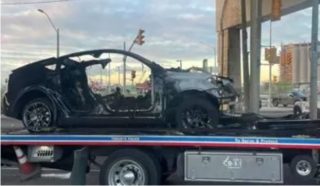
In a tragic turn of events that underscores the dangers of modern transportation, a Tesla vehicle carrying four Indian nationals from Godhra, Gujarat, met a horrific fate in Toronto. The car collided with a guardrail, leading to a catastrophic fire that claimed the lives of all four passengers: Keta Gohil (30), Neel Gohil (26), and two others. This incident occurred in the early hours of October 24, around midnight, leaving the Indian community in Canada mourning the untimely loss of their compatriots.
Witnesses reported that the Tesla was traveling at a high rate of speed when the driver lost control and struck the divider. The impact was so severe that it caused the vehicle’s battery to ignite, engulfing the car in flames almost instantly. While emergency responders arrived promptly, they found that four adults had already succumbed to the fire. However, one female passenger was rescued by a bystander and is currently hospitalized with serious but non-life-threatening injuries.
This tragic incident has reignited discussions about the safety of electric vehicles, particularly regarding their performance in accidents. Despite Tesla’s strong safety record and advanced technology, this event raises critical questions about how electric vehicles handle collisions and the subsequent risk of fire. As electric cars become more prevalent on roads worldwide, ensuring their safety in extreme situations becomes increasingly vital.
As investigations into the crash continue, authorities are focusing on factors such as speed and vehicle control. The community’s grief is palpable, but amidst this sorrow, one can’t help but think: if only the Tesla had been equipped with a “slow down” button that worked as well as its autopilot feature!

























